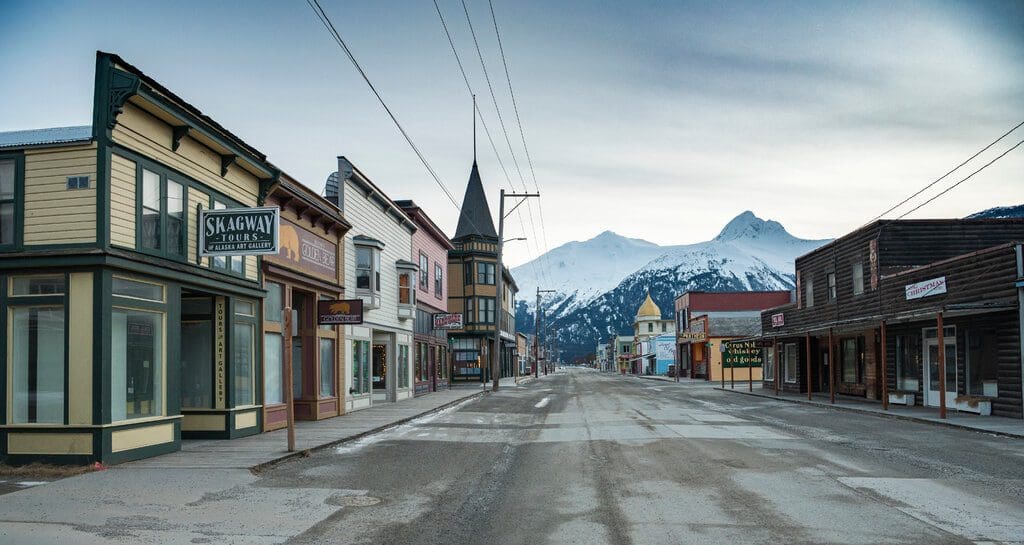Instead of reserving CARES Act stimulus funds for municipal operations — like everywhere else in the United States — Skagway leaders decided to redistribute most of the money to residents.
By Peter Kujawinski
Normally around now, Skagway residents start getting serious about the summer ahead. It’s no joking matter, because if you count the May and September shoulder season, they have to make all their money for the year in five intense months. On a busy summer day, 13,000 passengers disembark from cruise ships to soak up the atmosphere of this Gold Rush-era town in southeast Alaska surrounded by glaciers, mountains, deep fjords and the wilderness of Tongass National Forest.
Despite a year-round population of only a thousand people, before the pandemic Skagway was the 18th most visited cruise ship port in the world, with $160 million flowing annually into its economy.
For the summer of 2020, Skagway was expecting 1.3 million tourists to stroll down Broadway, its main street of historic saloons and hotels turned souvenir shops. It’s the kind of tourist-focused town that even Mayor Andrew Cremata has a side gig selling tours at the dock.
Covid transformed Skagway from cruise ship fueled boom town to ghost town. There were no cruise ship visits in 2020, and 2021 looks grim as well. To make matters worse, the pandemic didn’t just destroy its economy; it also cut off Skagway’s land connection to the rest of the world.
The only road out of town leads to the currently closed Canadian border about 20 miles away.

To avoid a mass exodus of residents, the town came up with a unique idea. Instead of reserving CARES Act stimulus funds for municipal operations — like everywhere else in the United States — Skagway leaders decided to redistribute most of the money to residents.
Each full-time resident, regardless of age, received $1,000 monthly from June to December 2020, on one condition: they had to spend the money within town.
It could be used to pay a mortgage, to buy groceries at Skagway’s two grocery stores, home improvement supplies at the town’s hardware store, or to patronize the town’s DVD rental store. Receipts proving the purchase was local were required.

To Mayor Cremata and other local leaders like Jaime Bricker, president of the Skagway Traditional Council, the rationale was simple: ensure the town’s survival until tourists returned.
Other programs they set up included vaccine distribution, coronavirus testing, paying for residents’ medevac insurance as well as helping the town’s food bank and highly rated school.
“We had one goal a year ago: make it through to the ’21 season,” the mayor said. “Highly successful. We’re going to make it to the ’21 season.” He paused. “And so, now, we have to make a new goal.”
Mr. Cremata was referring to the fact that on Feb. 4, the government of Canada extended a ban on cruise ships in its territorial waters until Feb. 28, 2022. This decision effectively has canceled Skagway’s summer 2021 season.

Town leaders have batted around options. For example, they have proposed a Save Our Skagway campaign, encouraging former seasonal workers to come back and visit. “You can come here and probably have the best vacation of your life without a lot of traffic in town and do all the things you didn’t get to do when you were working 70 hours a week through the summer,” Mr. Cremata said.
But no one expects this or any other option being discussed to make up for the usual summer influx of cruise ships.
“Businesses have gotten used to the volume that we see from the cruise industry,” Ms. Bricker said

This is certainly the case for Ashley Call and his company, Ocean Raft Alaska. “The more the merrier for my business and honestly, in Skagway, most of the tour businesses are set up the same way. My doors will stay closed unless I have the volume,” he said, adding that he would be working in construction until the cruise ships returned.
To make it through 2021, Mr. Cremata hopes any new stimulus package would include funding for hard-hit municipalities like his. But beyond just surviving another year, the mayor says current circumstances have provoked questioning among residents about tourism and Skagway’s future.
“What’s good for Skagway? Is it healthy to be working 70 hours a week when your kids are out of school or is it healthier to have an economy that is a little bit more sustainable, not only from an economic perspective, but from a personal perspective?” Mr. Cremata said.
“People have said in the past, I won’t even go down Broadway. I won’t even go to the post office when the cruise ships are here.”
Mr. Cremata laughed. “There’s always a dichotomy in Skagway. As much as people might complain about going down Broadway, people love tourists here. And I do too.”
_____
Peter Kujawinski , a Chicago-based writer, is a former U.S. diplomat and the co-author of five books, including Nightfall and Edgeland.
To see original article please visit: https://www.nytimes.com/interactive/2021/03/07/travel/covid-travel-tourism.html#skagway
















